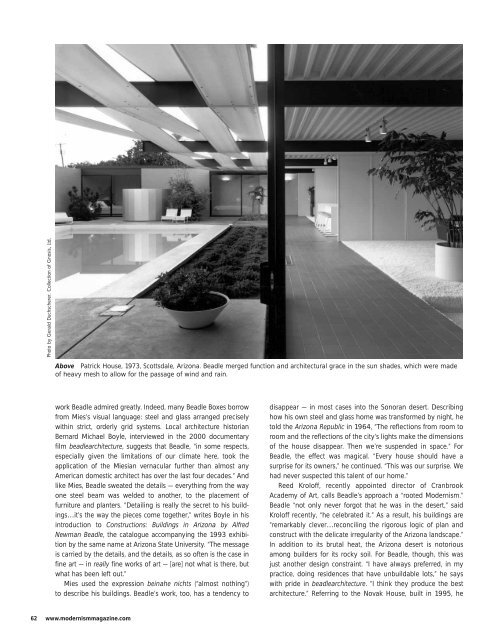Meet the BEADLES - Peter J. Wolf
Meet the BEADLES - Peter J. Wolf
Meet the BEADLES - Peter J. Wolf
You also want an ePaper? Increase the reach of your titles
YUMPU automatically turns print PDFs into web optimized ePapers that Google loves.
Photo by Gerald Duchscherer. Collection of Gnosis, Ltd.<br />
Above Patrick House, 1973, Scottsdale, Arizona. Beadle merged function and architectural grace in <strong>the</strong> sun shades, which were made<br />
of heavy mesh to allow for <strong>the</strong> passage of wind and rain.<br />
work Beadle admired greatly. Indeed, many Beadle Boxes borrow<br />
from Mies’s visual language: steel and glass arranged precisely<br />
within strict, orderly grid systems. Local architecture historian<br />
Bernard Michael Boyle, interviewed in <strong>the</strong> 2000 documentary<br />
film beadlearchitecture, suggests that Beadle, “in some respects,<br />
especially given <strong>the</strong> limitations of our climate here, took <strong>the</strong><br />
application of <strong>the</strong> Miesian vernacular fur<strong>the</strong>r than almost any<br />
American domestic architect has over <strong>the</strong> last four decades.” And<br />
like Mies, Beadle sweated <strong>the</strong> details — everything from <strong>the</strong> way<br />
one steel beam was welded to ano<strong>the</strong>r, to <strong>the</strong> placement of<br />
furniture and planters. “Detailing is really <strong>the</strong> secret to his buildings…it’s<br />
<strong>the</strong> way <strong>the</strong> pieces come toge<strong>the</strong>r,” writes Boyle in his<br />
introduction to Constructions: Buildings in Arizona by Alfred<br />
Newman Beadle, <strong>the</strong> catalogue accompanying <strong>the</strong> 1993 exhibition<br />
by <strong>the</strong> same name at Arizona State University. “The message<br />
is carried by <strong>the</strong> details, and <strong>the</strong> details, as so often is <strong>the</strong> case in<br />
fine art — in really fine works of art — [are] not what is <strong>the</strong>re, but<br />
what has been left out.”<br />
Mies used <strong>the</strong> expression beinahe nichts (“almost nothing”)<br />
to describe his buildings. Beadle’s work, too, has a tendency to<br />
62 www.modernismmagazine.com<br />
disappear — in most cases into <strong>the</strong> Sonoran desert. Describing<br />
how his own steel and glass home was transformed by night, he<br />
told <strong>the</strong> Arizona Republic in 1964, “The reflections from room to<br />
room and <strong>the</strong> reflections of <strong>the</strong> city’s lights make <strong>the</strong> dimensions<br />
of <strong>the</strong> house disappear. Then we’re suspended in space.” For<br />
Beadle, <strong>the</strong> effect was magical. “Every house should have a<br />
surprise for its owners,” he continued. “This was our surprise. We<br />
had never suspected this talent of our home.”<br />
Reed Kroloff, recently appointed director of Cranbrook<br />
Academy of Art, calls Beadle’s approach a “rooted Modernism.”<br />
Beadle “not only never forgot that he was in <strong>the</strong> desert,” said<br />
Kroloff recently, “he celebrated it.” As a result, his buildings are<br />
“remarkably clever…reconciling <strong>the</strong> rigorous logic of plan and<br />
construct with <strong>the</strong> delicate irregularity of <strong>the</strong> Arizona landscape.”<br />
In addition to its brutal heat, <strong>the</strong> Arizona desert is notorious<br />
among builders for its rocky soil. For Beadle, though, this was<br />
just ano<strong>the</strong>r design constraint. “I have always preferred, in my<br />
practice, doing residences that have unbuildable lots,” he says<br />
with pride in beadlearchitecture. “I think <strong>the</strong>y produce <strong>the</strong> best<br />
architecture.” Referring to <strong>the</strong> Novak House, built in 1995, he


